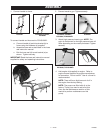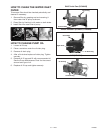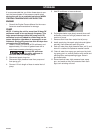
4 — ENG
D22885
HAZARD
• Fuel or oil can leak or spill and could
result in fire or breathing hazard, serious
injury or death can result. Fuel or oil leaks
will damage carpet, paint or other sur-
faces in vehicles or trailers.
• If pressure washer is equipped with a fuel
shut-off valve, turn the valve to the off position
before transporting to avoid fuel leaks. If pres-
sure washer is not equipped with a fuel shut-
off valve, drain the fuel from tank before trans-
porting. Only transport fuel in an OSHA
approved container. Always place pressure
washer on a protective mat when transporting
to protect against damage to vehicle from
leaks. Remove pressure washer from vehicle
immediately upon arrival at your destination.
WHAT CAN HAPPEN HOW TO PREVENT IT
RISK OF
ELECTRICAL
SHOCK
RISK OF CHEMICAL BURN
RISK OF HOT SURFACES
RISK TO FLUID
INJECTION
The powerful spray from your pressure washer is capable of causing damage to surfaces such as
wood, glass, automobile paint, auto striping and trim, and delicate objects such as flowers and
shrubs. Before spraying, check the item to be cleaned to assure yourself that it is strong enough to resist damage from
the force of the spray. Avoid the use of the concentrated spray stream except for very strong surfaces like concrete and
steel.
Operating without flow of water will result in equipment damage. Operating the pressure washer with water supply
shutoff will void your warranty. You should never run this pressure washer for more than 2 minutes without pulling the
trigger to allow cool water to enter the pump and the heated (recirculated) water to exit.
RISK OF INJURY AND
PROPERTY DAMAGE
WHEN TRANSPORTING OR
STORING
• Spray directed at electrical outlets or
switches, or objects connected to an elec-
trical circuit, could result in a fatal electri-
cal shock.
• Unplug any electrically operated product
before attempting to clean it. Direct spray
away from electric outlets and switches.
• Your washer operates at fluid pressures
and velocities high enough to penetrate
human and animal flesh, which could
result in amputation or other serious
injury. Leaks caused by loose fittings or
worn or damaged hoses can result in in-
jection injuries. DO NOT TREAT FLUID IN-
JECTION AS A SIMPLE CUT! See a phy-
sician immediately!
• Relieve system pressure before attempting
maintenance or disassembly of equip-
ment.
• Never place hands in front of nozzle.
• Direct spray away from self and others.
• Make sure hose and fittings are tightened
and in good condition. Never hold onto the
hose or fittings during operation.
• Do not allow hose to contact muffler.
• Never attach or remove wand or hose fittings
while system is pressurized.
• Use only hose and high pressure accessories
rated for pressure higher than your pressure
washer's p.s.i.
• To relieve system pressure, shut off engine,
turn off water supply, and pull gun trigger until
water stops flowing.
• Use of acids, toxic or corrosive chemicals,
poisons, insecticides, or any kind of flam-
mable solvent with this product could re-
sult in serious injury or death.
• Do not use acids, gasoline, kerosene, or any
other flammable materials in this product.
Use only household detergents,
cleaners and degreasers recommended for
use in pressure washers.
• Wear protective clothing to protect eyes and
skin from contact with sprayed materials.
• Do not use chlorine bleach or any other cor-
rosive compound.
• Contact with hot surfaces, such as engines
exhaust components, could result in seri-
ous burn.
• During operation, touch only the control sur-
faces of the pressure washer. Keep children
away from the pressure washer at all times.
They may not be able to recognize the haz-
ards of this product.


















